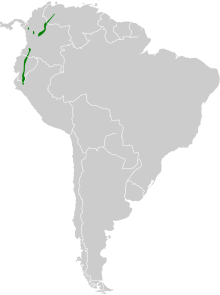Glowing puffleg
| Glowing puffleg | |
|---|---|

| |
| Scientific classification | |
| Kingdom: | Animalia |
| Phylum: | Chordata |
| Class: | Aves |
| Order: | Apodiformes |
| Family: | Trochilidae |
| Genus: | Eriocnemis |
| Species: | E. vestita
|
| Binomial name | |
| Eriocnemis vestita (Lesson, 1838)
| |

| |
The glowing puffleg (Eriocnemis vestita) is a species of hummingbird in the family Trochilidae.
It is found in the Andes of Colombia, Ecuador, northern Peru and western Venezuela. Its natural habitats are subtropical or tropical moist montane forest and heavily degraded former forest.
Description[]
The glowing puffleg is a medium-sized hummingbird. It measures about 4.1 - 4.3 inches (10.5 - 11 centimeters) in length including its beak and tail. The beak itself is about 0.7 inches (1.8 centimeters long).[2] The average weight is 4.3 - 5.3 grams.[3]
The males are mostly green with a blue throat. They have a glittering emerald blue belly, and blue undertail coverts. As for the females, they have a paler buff colored belly and a speckled appearance. Both the males and females have large white puffs at the base of their legs.[4]
Like most hummingbirds, the glowing puffleg is silent, with an occasional bird call described as monotonous repeated metallic "tsip tsip tsip".[4]
This bird is hard to spot because it does not stay in sight for long. They are most often found hovering over or briefly clinging onto small tubular flowers as they gather the nectar from low shrubs. glowing pufflegs are territorial and protect the flowers that they gather nectar from.[5]
Taxonomy[]
The glowing puffleg species belongs to the Apodiformes order, the Trochilidae subfamily of hummingbirds, and the Erionemis genus. The scientific name of the glowing puffleg species is Erionemis vestitia, although, the name may vary depending on its geographic home. In the east Andes of Colombia and north-west Venezuela lives the Eriocnemis vestita vestita. Eriocnemis vestita paramillo are found in the north end of Western and Central Andes of Colombia. Eriocnemis vestita smaragdinipectus live in the Central Andes of Colombia and in Ecuador. In the Andes of south Ecuador and North Peru lives the Eriocnemis vestita arcosae.[6]
Subspecies[5][]
- Eriocnemis vestita paramillo
- N parts of W and C Andes of Colombia (Antioquia)
- Eriocnemis vestita vestita
- NW Venezuela (Mérida) and E and C Andes of Colombia (S to Cundinamarca and Huila)
- Eriocnemis vestita smaragdinipectus
- S Colombia (C Andes in Cauca) S to Andes of Ecuador (S to Cañar)
- Eriocnemis vestita arcosae
- Andes of S Ecuador (Azuay) S to extreme N Peru (E Piura, N Cajamarca)
Alternate Global Names[]
Spanish: Calzadito Reluciente
Italian: Colibrí Zampepiumose Smagliante
French: Érione Pattue
Latin: Ericonemis Vestitus
Japanese: Hikariwataashihachidori
Czech: Kolibrík žhnoucí
Danish: Glitrende Kvastben
German: Bronzeschneehöschen[4]
Reproduction[]
Glowing puffleg's do not migrate in flocks, so when breeding, males attract females by flying in a U-shaped pattern in front of them. The glowing puffleg is a species that is solitary, besides breeding. Males are only involved in mating with the female in the reproductive process. Both the male and female glowing pufflegs will have several mating partners. Males are only involved in mating with the female in the reproductive process.[4]
The clutch usually contains two white eggs that are incubated by the mother. During the incubation, the father is protecting the territory surrounding the nest and the flowers they feed on. The chicks are born blind and immobile. To feed the chicks, the mother pushes food down her beak through the chick's throats and into their stomachs. The chicks rely on their mother for food for about two weeks, and are able to fly within 20 days of birth.[3]
Diet[]
The diet of the glowing puffleg includes the nectar from small flowering trees, small spiders, insects, shrubs, herbs, and epiphytes.[3]
References[]
- ^ BirdLife International (2016). "Eriocnemis vestita". IUCN Red List of Threatened Species. 2016: e.T22687914A93174907. doi:10.2305/IUCN.UK.2016-3.RLTS.T22687914A93174907.en. Retrieved 12 November 2021.
- ^ "Glowing Pufflegs | Beauty of Birds". www.beautyofbirds.com. Retrieved 2021-09-30.
- ^ a b c Devotor, Mr (2021-08-03). "The Glowing Puffleg (Eriocnemis vestita)". Charismatic Planet. Retrieved 2021-10-10.
- ^ a b c d "Glowing Puffleg - eBird". ebird.org. Retrieved 2021-09-30.
- ^ a b Heynen, Iris; Boesman, Peter F. D.; Kirwan, Guy M. (2020-03-04). "Glowing Puffleg (Eriocnemis vestita)". Birds of the World.
- ^ "Eriocnemis vestita (Glowing Puffleg) - Avibase". avibase.bsc-eoc.org. Retrieved 2021-10-05.
- IUCN Red List least concern species
- Eriocnemis
- Birds of the Colombian Andes
- Birds of the Ecuadorian Andes
- Birds described in 1838
